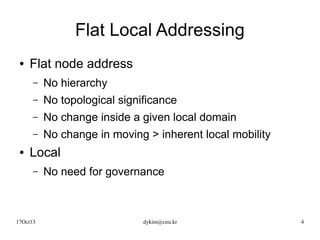Global naming & local addressing
- 1. Global Naming & Local Addressing Dae Young KIM 17Oct13 dykim@cnu.kr 1
- 2. Architecture ˇń Hierarchical Global Name ˇń Flat Local Address ˇń Late binding ˇń NAT as a norm ˇń Name nodes, not interfaces 17Oct13 dykim@cnu.kr 2
- 3. Hierarchical Global Naming ˇń Hierarchical ¨C Bottom-up pruning ˇń cnu.ac.kr, cnu.kr, cnu.edu ¨C In contrast to topdown allocation/distribution ˇń IP address ¨C Minimal governance; against duplicity ˇń Global ¨C xyz.ccl.cnu.kr.globe.solar.galaxy 17Oct13 dykim@cnu.kr 3
- 4. Flat Local Addressing ˇń Flat node address ¨C No hierarchy ¨C No topological significance ¨C No change inside a given local domain ¨C No change in moving > inherent local mobility ˇń Local ¨C No need for governance 17Oct13 dykim@cnu.kr 4
- 5. Late Binding and NAT ˇń Late Binding ¨C ccl<cnu<ac<kr<globe<solar<galaxy | | | | | | a1< a2 <a3<a4< a5 < a6 < ˇń NAT ¨C Norm, not an anomaly 17Oct13 dykim@cnu.kr 5
- 6. Consequences ˇń Governance-free ¨C Minimal for names ¨C None for addresses ˇń Inherently scalability ¨C Divide and Conquer ˇń Inherent local mobility ¨C NAT mobility transversal: engineering challenge ˇń From e2e to middle-box 17Oct13 dykim@cnu.kr 6






